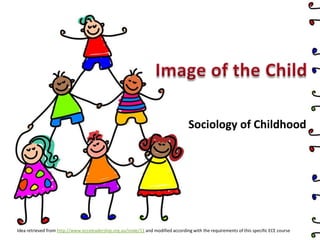
Image of the child revised
- 1. Sociology of Childhood Idea retrieved from http://www.ecceleadership.org.au/node/11 and modified according with the requirements of this specific ECE course
- 2. Why to discuss this topic? • Today we take for granted that there’s a stage in life which is known as “childhood” • However, it has been argued that “childhood” is rather a creation of society than a natural phenomenon • As ECE professionals we will have our own ‘mental models’ of childhood, which are the images, assumptions, and stories we carry in our minds (Raelin, 2007 p. 501).
- 3. The views • Early childhood care and education also has a history of different images and beliefs about children and the way that children develop and learn. • The beliefs and practices of ECE professionals have been influenced by the writings of philosophers and researchers such as Froebel, Montessori, and Steiner and more recently by the ideas from the works of Piaget, Vygotsky, Rogoff, Bronfenbrenner, etc. (Edwards & Hammer, 2006; Kennedy, 2006).
- 4. Depiction of Children John Singer Sargent (1856-1925) Retrieved from http://artblogbybob.blogspot.co m/2008/01/great- expectations.html William Hogarth ‘The House of Cards’ 1730 Retrieved from http://hogarth.chez- alice.fr/gallery20.htm Children at Play Retrieved from http://www.wolverhamptonhistory. org.uk/people/victorian_childhood/ playtime During the eighteenth and nineteenth centuries, a dominant image of childhood was universalised with the introduction of mass schooling and new laws that sought to provide children with greater protection. This resulted in a more sentimental view of children that emphasised their innocence and vulnerability (Prout, 2005, p. 9).
- 5. Childhood by Ten as it is presented in R. Sorin’s Changing Images of Childhood – Reconceptualizing Early Childhood Practice” (2005) 1. The Innocent Child 2. The Noble/ Saviour Child 3. The Evil Child 4. The Snowballing Child 5. The out-of-control child 6. The Miniature Adult 7. The Adult-in-Training 8. The Child as Commodity 9. The Child as Victim 10. The Agentic Child
- 6. A Child in Need or a Competent Child? • In developmental psychology, as Verhellen (1997) suggests, “children are in a state of ‘not yet being’; the dominant image of the child is of a ‘human becoming rather than a human being” ( Woodhead & Faulkner, 2008,p. 15) • Image of the child in need is associated with protection of children’s rights • Image of the competent child is associated with participation rights • Recently, there’s been a shift away from a traditional belief that early childhood is a time when immature human beings are socialized and developed towards adulthood • It’s been acknowledged that young children have their own concerns, interests, points of view
- 7. Present-day Depiction of Children Dankin toy company in opposition to violence games Retrieved from http://www.focusonlinecommuni ties.com/blogs/Finding_Home/20 11/06 On the other side Played out over time and shaped by different circumstances the modern idea of childhood came into existence.
- 8. UN Convention on the Rights of the Child Article 12 Express your opinion The United Nations Convention on the Rights of the Child (1989) is an international legal instrument that outlines a specific body of identifiable rights for children. One of its guiding principles, age-appropriate participation, holds that young people have the right to express their views in matters affecting them (Article 12). While all members of the United Nations have ratified the Convention (with the exception of the United States and Somalia), there is still a great deal of controversy surrounding the participatory principle. Critics argue that children do not possess the emotional or cognitive capabilities needed to make rational choices (Purdy, 1992). Johny,L. (2006). Reconceptualizing childhood: Children’s rights and youth participation in schools. International Education Journal, 2006, 7(1), 17-25. Shannon Research Press. http://iej.cjb.net
- 10. What can ECE professionals do? The young child is understood and recognized as being a part of & a member of society Active engagement of young children with the world requires adults to take this engagement seriously Dahlberg, G., Moss, P. & Pence, A. (2007). Beyond Quality in Early Childhood Education and Care: languages of Evaluation. (2nd ed.). Routledge: New York
